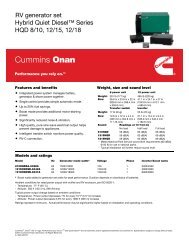Air Brake Manual
Air Brake Manual
Air Brake Manual
Create successful ePaper yourself
Turn your PDF publications into a flip-book with our unique Google optimized e-Paper software.
Single Unit (Not for air over hydraulic brake<br />
systems)<br />
When upgrading your driver’s licence from single to<br />
combination vehicles with air brakes, you will be<br />
required to satisfactorily demonstrate the complete<br />
pre-trip air brake inspection for combination vehicles.<br />
The pre-trip air brake inspection should be completed<br />
within 20 minutes. Failure to complete the test within<br />
20 minutes may result in the test being discontinued.<br />
Practical examination will be conducted in either the<br />
metric or imperial systems of measurement,<br />
whichever coincides with the equipment being<br />
operated.<br />
Vehicle Secure<br />
· Set the spring parking brake on the vehicle.<br />
· Block the wheels; the vehicle should be on level<br />
ground if possible.<br />
· Check that the compressor is secure.<br />
· Check the drive belt and pulleys for wear, cracking,<br />
slippage and tension (if equipped).<br />
· Drain all reservoirs completely (wet/supply reservoir<br />
first). When reservoirs are empty close the drain<br />
valves. “For testing purposes only, the applicant will<br />
not be required to manually drain the reservoirs.<br />
Instead, the applicant will verbally explain the steps<br />
that they must follow when draining the reservoirs<br />
and then fan the brake pedal to empty the<br />
reservoir.”<br />
· Check brake chambers, air lines and slack adjusters<br />
for security and wear.<br />
Compressor and Warning Devices Check<br />
· Start the engine and run at fast idle to build air<br />
pressure.<br />
· Warning device(s) must operate to 55 psi or higher.<br />
· Ensure reservoir air pressure builds from 50 to 90 psi<br />
within three minutes.<br />
· Release the spring parking brake at 90 psi or above<br />
to prevent compounding the brake pressure.<br />
· Continue building reservoir air pressure. Check that<br />
the governor places the compressor in the<br />
unloading stage between 115 psi minimum and 135<br />
psi maximum.<br />
· Fan the brake pedal until the pressure drops to 80<br />
psi; stop fanning to see if the governor has placed<br />
the compressor in the loading stage (the reading<br />
on the air pressure gauge should increase).<br />
· Continue fanning the brake pedal. Warning<br />
device(s) must operate at or before 55 psi and the<br />
spring parking brake should apply at or before the<br />
reservoir pressure drops to 20 psi.<br />
Check for Leakage<br />
· Rebuild reservoir air pressure at fast idle. When<br />
the pressure reaches 90 psi release the spring<br />
parking brake. Continue to build pressure to<br />
between 115 psi minimum and 135 psi maximum.<br />
· Shut off the engine.<br />
· Make a full brake application with the foot valve<br />
and hold. Observe the reservoir air pressure<br />
gauge.<br />
· The reading should not drop more than 3 psi per<br />
minute. Lightly tap the gauge to ensure it is not<br />
sticking. For an accurate reading brake<br />
application should be held for at least two<br />
minutes.<br />
· Listen for audible air leaks.<br />
· Release full brake application.<br />
<strong>Brake</strong> Adjustment<br />
(A driver should be trained in brake adjustment prior<br />
to attempting practical examination and supply the<br />
equipment required to do a brake adjustment.)<br />
The following are recommended steps to determine<br />
if an S-cam brake with manual slack adjusters<br />
requires adjustment.<br />
· Ensure vehicle is secure and wheels are blocked.<br />
Verify the system is at full pressure.<br />
· Shut off the engine. Leaving the transmission in a<br />
low gear or park.<br />
· Release the spring parking brakes.<br />
72




